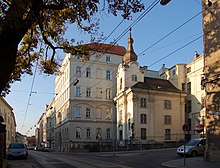Convent of the Sisters of the Poor Child of Jesus (Vienna)
The monastery of the sisters of the poor child of Jesus is a sister monastery in the Oberdöbling district of the 19th district of Döbling in Vienna . The monastery also includes a Roman Catholic monastery church and the Maria Regina school center (informally also known as Hofzeile after its location ) with a kindergarten , elementary school , BG / BRG , educational institute for kindergarten pedagogy (BAKiP) and after-school care center .
history
In 1857 the sisters of the poor child Jesus came to Vienna and bought an older house in Döblinger Hauptstrasse 83 and the Johann Nepomuk Chapel. After the house was demolished, the sisters of the Catholic School Order erected the corner building that still exists today and built school buildings in the Hofzeile, where there was also a teacher training center that has since been closed.
Johann Nepomuk Chapel
The monastery chapel existed before the monastery sisters arrived in Döbling. The Viennese citizen Wolff Josef Hoffmändl von Mangeram had it built as a private chapel between 1726 and 1739. At that time, Oberdöbling had already become a popular summer resort and the medieval parish church was often felt to be too small. The clergy from Lichtental and Währing working here were paid privately. When in 1783 Emperor Joseph II redesigned the church organization in Austria , he allegedly came to Oberdöbling himself to decide whether the neighboring church of St. Paul or the private chapel should be elevated to the new parish church of Döbling. The choice finally fell on St. Paul, but the Johann Nepomuk Chapel was closed in 1785 and the facility was auctioned. The desecrated chapel was sold to a carpenter who used it as a warehouse. However, since St. Paul's Church was very desolate and still had not been repaired, an application was made in 1794 to be allowed to use the church again. It was then actually re-consecrated and refurbished. Between 1826 and 1829, when the St. Paul's Church was rebuilt, the church even served as a parish church. Then the building was desecrated again and used as the first Döblingen theater hall. But this phase lasted only a short time. In 1861 the church was rededicated by the sisters. As early as 1885, due to the increasing number of schoolgirls, the sisters had a new church built and desecrated the small church again. A false ceiling has now been installed in the church, with the upper part being used for meetings and the lower part as a dining room. This separation still exists today. The figures of St. Florian and St. Leopold are still visible on the main facade .
Monastery Church of the Holy Family
The simple gallery basilica with a gable facade in the late historical style with romanized forms with a retracted choir and an attached tower stands with the northern longitudinal facade in the street line of the courtyard. The monastery church was built from 1885 to 1886 according to the plans of the architect Friedrich Luckner and consecrated in 1887.
Figural paintings were created by the painter Josef Kastner in 1884, two wooden figures Madonna and Josef were created by the sculptor Leopold Kastner in 1886, and pictures of the Stations of the Cross on sheet metal were created by the painter Maria Schöffmann in 1897. There is a bell by Franz Josef Scheichel from 1766.
literature
- Godehard Schwarz: Döbling. Ten historical walks through Vienna's 19th district. Vienna 2004.
Web links
Individual evidence
- ↑ Dehio Wien Vororte 1996 , Döbling, Klosterkirche Holy Family of the Sisters of the Poor Child Jesus, Hofzeile at No. 22, pages 537f
Coordinates: 48 ° 14 ′ 32.6 ″ N , 16 ° 21 ′ 19.1 ″ E




